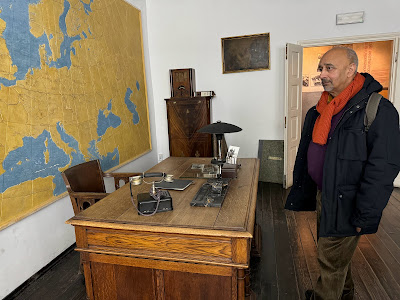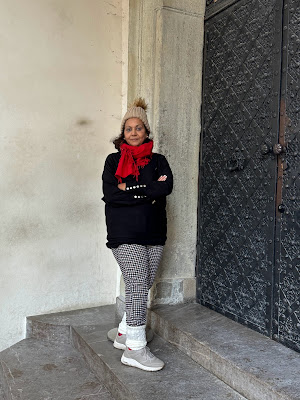The Legend of The Shiva Wawel Chakra in Krakow, Poland. Blog 45. 03/12/2023 nguptatravelscrapbook.blogspot.com
The Legend of The Shiva Wawel Chakra in Krakow, Poland.
Blog 45, posted on 03/12/2023.
nguptatravelscrapbook.blogspot.com
"Meeting Shiva is easy, from thing, we just need to discover The No-Thing
&#Shiva is just there with us, in us, all the time
Just because we remain blind by seeing ourselves in things, he is not visible to us
Everything, be it our body, food, materials, thoughts, emotions, are just
but only things. When there are "No things, There is Shiva."
By Vivek Sharma.
Last week, my husband and I had a chance to visit Krakow, the second-largest metropolitan city in Poland, to experience its most celebrated and most fabulous Christmas Markets in its central Square in the old town. This is how Krakow is promoted at this time of the year when travellers are okay with visiting the festive Christmas Markets even in suboptimal weather. We confronted substantial snowfall on the day of our arrival, with temperatures enduring around -8C for the entire trip.
Poland's second-largest city is very diverse to its capital. While Warsaw was nearly destroyed in the Second World War, Krakow emerged unscathed, mainly due to its role as a supply base for the Third Reich.
Krakow is perfect for a three-day city break all year round, easily accessible by daily budget flights from the UK and Europe. During this trip, I noticed four flights from the Krakow airport leaving for London, Stansted, Leeds, and Manchester simultaneously, signifying that Krakow remains a very likeable tourist spot in winter, too.
Krakow is easily one of the most walkable cities in Europe, abounding with charm; its streets are ingrained with history, exuberance, quirkiness and enjoyment.
Krakow, situated on both sides of the upper Vistula River, is one of the largest cities in southern Poland. It is known primarily for its grand historic architecture and cultural leadership; UNESCO designated its old town a World Heritage status in 1978. Locals frequently call Krakow the Athens of Poland (Polskie Ateny).
The medieval city centre, the Wawel Hill complex and Kazimierz ( the Jewish settlements) areas include hundreds of years of history and architecture and provide a memorable backdrop for a reason to visit Krakow as you walk through its streets, Cathedral, churches and buildings with stunning examples of gothic, renaissance and baroque styles. The city offers a winning combination: a vast medieval market square where the Christmas Market continues to New Year's Day with low merchandise prices.
UNESCO World Heritage-listed Auschwitz -Birkenau, a former Nazi concentration camp tour, is available from Krakow( about 45 min drive) with a professional guide portraying the horrors of the Holocaust.
The famous Oskar Schindler ( From Schindler's List fame) has a museum dedicated to the horrors of WW2, whereby the Schindler's enamelware factory in Kazimierz, Krakow, was transformed into a gallery and a museum in 2010. It carries out various educational activities on WW2 and the Holocaust, commemorating the war victims by collecting and sharing war souvenirs from Krakow. It was remarkable that even during weekdays, most tourist sites were jam-packed with school children brought in by their peers eager to learn their country's notable history.
When I visited the Schindler's factory/ museum, the fascinating area for me was viewing a collection of enamelware produced in this factory before and during WW2 and the real-time office of Oskar Schindler.
Apart from the city centre being renowned as a World Heritage site, the Wieliczka salt mines(about 20 km from Krakow) have the same status and hold an exclusive place in Poland's economic history. It was well worth our visit during this trip.
I was ready to immerse in awe-inspiring pieces of history while experiencing the charms of this timeless city. The Wawel Hill complex perfectly captures the essence of Poland's heritage and is a testimony of its past glories and victories.
While doing my preliminary project on Krakow's attributes and planning my itinerary, I came across a legend about the city that a Holy stone is embedded in the grounds of the city's most prominent site, the Wawel Castle and the Cathedral. These two monuments are located on Wawel Hill, the city's highest and most picturesque visuals. The heart of Krakow, the Stare Miasto, is shaped like a light bulb, with the Wawel Hill as the end of the stem and the bulb itself defined by the city walls. Much of it is pedestrianised, with most of the traffic flowing around the perimeter using a road that follows the line of the old city walls.
Researching via Wikipedia, I discovered more details of this so-called Holy Stone, the Wawel Chakra.
The Wawel Chakra (Polish: Czakram Wawelski) on the Wawel Hill in Kraków, Poland, is believed to emanate powerful spiritual energy. Disciples believe it to be one of the world's leading spiritual energy centres.
A Chakra is a natural energy point or centre of consciousness found in every living being, as believed in India's religious, spiritual and yogic traditions. The Chakra Stone legend is one of Wawel's most well-known but officially unendorsed legends.
Though the legend may be contentious, it simply states that hidden in Wawel Hill is a CHAKRA. This mysterious stone is a source of supernatural energy and unspeakable power, spreading unbelievable spiritual force. The legend refers to a tale of the Hindu God Shiva, who flung seven magical stones (the Chakram) into the seven parts of the world as a gift to humanity. Those seven stones landed in some of the most important spiritual centres today: Rome, Mecca, Delhi, Delphi, Jerusalem, and Velehrad. One of the Chakras hit Krakow Hill in the forecourt of Wawel Castle, precisely beneath the Chapel of St. Gereon.
At least that's where believers claimed to have felt its cosmic energy the strongest before the chapel was closed and the area around it was inaccessible. Nevertheless, you'll still find some believers and curious tourists in the northwest corner of Wawel's Renaissance courtyard (directly left of the courtyard entrance), trying to get near the energy source and absorb its good vibes by placing their hands or entire backs on the wall. I did the same once I located the spot after asking a shopkeeper lady in the precinct of the Castle. She directed me correctly to the spot of the Chakra. I pushed aside a tourist sign on a pole and stood at the suggested corner to feel cosmic energy while my husband took a few pictures.
At the same time, the ticket office lady did not welcome my request for the whereabouts of this Chakra. I read in one of the posts that the staff of Castle view the legend a nuisance and have done everything they can to deflect attention away from Wawel's famous corner, including putting up a sign, asking people to refrain from touching the wall, putting a rope around it, displaying museum exhibits or signs around it or over the top of it and having a guard standing nearby.
At the same time, some people credit the Chakra with protecting the city through its tumultuous history, but Wawel tour guides need to speak about the chakra stone, as you'll quickly learn if you broach the topic with one. The Catholic Church and its firm followers also dismiss the legend of the Chakra, even though its location at the most important spiritual site in the country, Wawel Cathedral, could just as easily be seen as a compliment. Wawel authorities have done everything possible to downplay the legend.
We had a busy city break and enjoyed ourselves despite the chilling weather.
Please feel free to upload your comments on this blog.


















Comments
Post a Comment